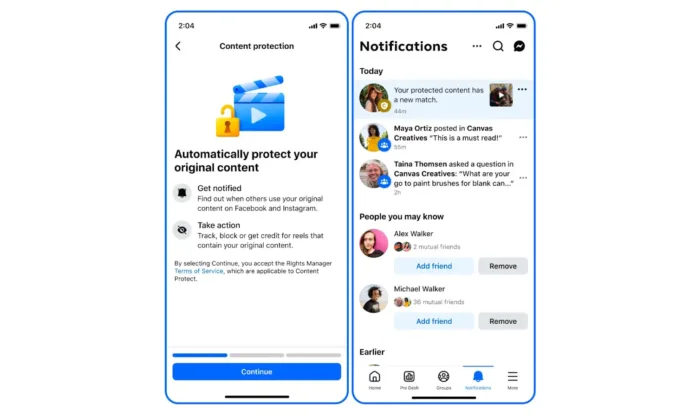Table of Contents
We see daily how creators struggle with content theft, silent reposting, and accounts that grow large audiences by copying material instead of creating it. Meta has now introduced Meta Content Protection, a mobile tool that gives original creators new control over how their reels are used across Facebook and Instagram. The company says this feature will help creators protect their work, build their identity, and avoid situations where copycat accounts benefit from someone else’s ideas.
This rewritten article expands the original report with deeper context, clearer explanations, and a wider view of why Meta Content Protection matters for creators today.
How Meta Content Protection Works
Meta Content Protection helps creators monitor how their reels appear across Facebook and Instagram. The system detects if another account uploads or reposts a reel that matches the creator’s original upload. If Meta identifies a match, the creator receives a notification inside the app.
Meta says the tool uses the same technology that powers its existing Rights Manager system. Rights Manager already helps copyright holders track and manage copyrighted media, and Meta Content Protection brings similar capabilities directly to reel creators who work on mobile. Instead of requiring a desktop dashboard or advanced copyright knowledge, the new tool gives creators quick control from their phone.
Read More About Our Article of Meta Launches “Ghost Posts” on Threads to Boost User Engagement with Temporary Content Published on October 29th, 2025 SquaredTech
Creators can take one of several actions if Meta flags a match:
- Block the reel’s visibility inside Facebook and Instagram.
The matched reel is no longer recommended or widely shown. Meta does not punish the account that reposted the content, but distribution stops immediately. - Track the reel’s performance across Meta’s platforms.
Creators can view engagement numbers and decide if they want the matched reel to remain online. - Add attribution links to show the original creator.
These attribution links add an “original” label to the matched reel. The label links to the creator’s page, profile, or, in some test cases, back to the original reel. Meta says linking to the page or profile is currently the default. - Release the claim if the creator wishes to allow the reel to stay online.
This option makes sense for collaborations, fan edits, or remixes where the creator supports reuse.
Meta also allows creators to build an “allow list.” This list includes accounts that have permission to reuse the creator’s reels. If a trusted collaborator or brand partner reposts a reel, the system ignores the match.
The percentage match appears in every flagged reel. Creators can see key details such as view count, follower count, and monetization status. This level of visibility helps creators understand the size of the repost and whether the reposting account is using the reel for engagement or monetized content.
Why Meta Created the Meta Content Protection System
Meta Content Protection exists because creator theft has increased as short video formats have grown. Meta said earlier this year that it removed around 10 million fake profiles that copied content from large creators. It also took action against 500,000 accounts that used spam tactics, fake engagement, or reposting strategies to build artificial followings.
Meta has a strong incentive to support original creators. Platforms rely on unique content, and original creators keep audiences loyal. If copycats consistently steal reels, creators lose trust in the platform.
The new tool also connects to Meta’s larger plan to support creators with monetization opportunities. Meta Content Protection is currently available to creators who meet Meta’s originality and integrity standards inside the Facebook Content Monetization program. Meta is also expanding access to creators who use Rights Manager.
Meta wants creators to upload reels directly to Facebook. Although the system can track reels posted on Instagram, it works best when the original reel is uploaded or cross-posted to Facebook. Meta hopes this requirement encourages creators to treat Facebook as a main platform instead of a secondary place for reposts.
SquaredTech sees this as a strategic decision by Meta. By pushing creators to upload to Facebook first, Meta strengthens its short-form video ecosystem and competes more directly with TikTok and YouTube Shorts.
Creator Control, Content Disputes, and Platform Enforcement
Meta Content Protection gives creators the ability to control how the system behaves. Meta says creators decide how aggressive the tool should be. If creators choose strong tracking, almost all matches appear in their dashboard. If creators prefer limited alerts, the system adjusts accordingly.
If an account falsely claims someone else’s reel, the original creator can dispute the claim. Creators can file a copyright takedown request through Meta’s IP reporting channel. They can also submit a report if the tool misses a match. The content protection overview screen includes an option titled “Can’t find a specific match?” for these situations.
Meta says it will restrict access for creators who misuse the tool. If a creator files repeated false claims to target competitors or critics, the system can remove access or apply other account limits. This rule helps prevent harassment through false copyright enforcement.
Meta also notes that blocking a matched reel only affects distribution. The reposting account does not receive a violation or penalty. Meta says this choice prevents users from weaponizing the feature against specific accounts. Instead, the emphasis is on controlling visibility rather than punishing users.
At this stage, Meta Content Protection is mobile-only. Meta is currently testing desktop access inside the Professional Dashboard. SquaredTech expects Meta to expand desktop support soon because many creators still manage rights and performance analytics on computers.
Why Meta Content Protection Matters for Creators in 2026
This part expands on the original report to give additional insight and meaningful context.
- Short video is now the dominant format.
Reels, TikToks, and Shorts attract large audiences. When a creator invests time in filming, editing, and branding a reel, losing ownership to a reposting account directly harms growth. - Copycat accounts undermine creator identity.
Accounts that repost without permission confuse audiences. If multiple accounts hold the same reel, viewers may not know which one belongs to the original creator. - Attribution links create new discovery pathways.
Meta’s approach gives creators visibility even if someone else reposts their work. The “original” label helps viewers find the source. - Meta wants to restore trust after past criticism.
Many creators complained that Meta and Instagram did not do enough to stop content theft. Meta Content Protection directly responds to those concerns. - It encourages cross-posting consistency.
Requiring Facebook uploads ensures smoother tracking. This may shift creator habits in 2026. - It aligns with Meta’s push for monetization expansion.
Meta wants creators to see Facebook as a platform where they can earn meaningful income. Protecting originality is part of that strategy. - It reduces spam and fake engagement tactics.
Removing fake profiles and copycat accounts creates a healthier environment for genuine creators. - It strengthens the creator ecosystem inside Meta platforms.
Creators who feel protected are more likely to build long-term communities on Facebook and Instagram.
Our team views Meta Content Protection as a step toward a more accountable creator economy. Many creators have demanded clearer rights tools for years. TikTok and YouTube have strong systems for copyright and audio matching. Meta is now moving closer to those standards with a mobile-first system that focuses on reels.
What Creators Should Do Next
Creators who want to use Meta Content Protection can check eligibility in several places:
Feed
Professional Dashboard
Profile notifications
Content Protection section inside the Professional Dashboard
Creators can also apply through Facebook’s website if they do not see the feature available yet.
Recommendations for Creators Using Meta Content Protection
SquaredTech advises creators to follow these steps to maximize the tool’s value:
Upload reels directly to Facebook
This ensures full match detection. Cross-posting from Instagram also works, but uploading to Facebook first gives stronger tracking accuracy.
Review matches at least once a week
Matches may appear quickly. A trending repost can affect reach within hours. Establishing a routine helps creators stay in control.
Use attribution links for discovery
If a fan page or commentary page reposts a reel, attribution links drive traffic back to the creator’s page. This can increase followers and improve algorithmic visibility.
Build a smart allow list
Include collaborators, editors, brand partners, or official fan accounts. This avoids unnecessary flagging and supports healthy relationships.
Use disputes to defend originality
If a false claim appears, creators should file a takedown request immediately. Fast action prevents long-term reach loss.
Monitor performance of reposts
Creators should study how reposted reels perform. Some creators use unofficial reposts as analytics signals to understand which themes or editing styles resonate with broader audiences.
Prepare for desktop expansion
Meta is testing desktop support inside the Professional Dashboard. Creators who manage rights and analytics on computers should be ready for expanded features.
This approach helps creators stay in control of their content, maintain their presence across Meta platforms, and protect their work from misuse.
SquaredTech will continue covering how Meta Content Protection evolves. Mobile-only features often grow into full dashboards with analytics, rights settings, and monetization tools. As Meta tests desktop support, creators should expect more improvements. With content theft increasing, tools like Meta Content Protection are essential for creators who want a safe, predictable environment for their work online.
Stay Updated: Tech News


